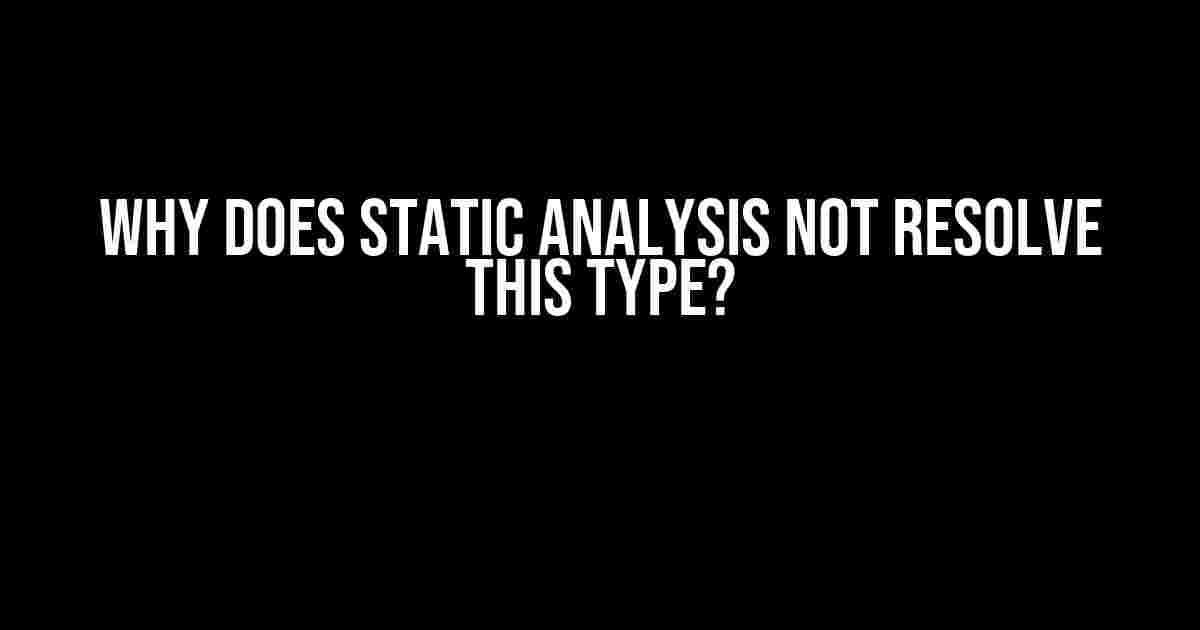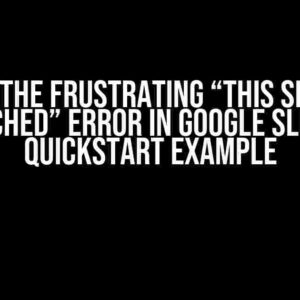Have you ever encountered an error message that says “static analysis cannot resolve this type”? It’s frustrating, isn’t it? You’ve written perfect code, but the analyzer just refuses to understand what you’re trying to do. In this article, we’ll dive deep into the world of static analysis and explore why this error occurs. Buckle up, because we’re about to get technical!
What is Static Analysis?
Before we dive into the error, let’s quickly review what static analysis is. Static analysis is a process of analyzing code without executing it. It’s like having a super-smart friend who reviews your code, searching for potential errors, bugs, and security vulnerabilities. This friend doesn’t run the code; they just read it and provide feedback.
Static analysis is essential in software development because it helps catch errors early, reducing the risk of bugs making it to production. It’s like having a safety net that prevents you from falling into the pit of errors.
Why Does Static Analysis Fail to Resolve a Type?
Now, let’s get back to our error. “Why does static analysis not resolve this type?” There are several reasons why this error occurs. Let’s explore them:
Typo in the Type Name
One common reason is a simple typo in the type name. Yes, it happens to the best of us! A single character mistake can make the analyzer go crazy. For example:
public class MyClazz {
private String myString;
public void setMyString(MySting myString) {
this.myString = myString;
}
}In this example, the type `MySting` should be `MyString`. A single `r` vs. `R` makes all the difference. Fix the typo, and the error disappears!
Missing Import Statements
Another reason is missing import statements. When you use a type from another package, you need to import it. Forgetting to add the import statement will confuse the analyzer. For example:
public class MyClass {
private ArrayList<String> myList;
public void addString(String str) {
myList.add(str);
}
}In this example, we’re using `ArrayList`, but we didn’t import it. Adding the import statement `import java.util.ArrayList;` resolves the issue.
Type Not Found in the Classpath
Sometimes, the type is not found in the classpath. This can happen when you’re using a custom type or a type from a library that’s not included in your project. For example:
public class MyClass {
private MyCustomType myType;
public void setType(MyCustomType type) {
myType = type;
}
}In this example, `MyCustomType` is not found in the classpath. You need to add the library or include the custom type in your project.
Generics Gone Wrong
Generics can be tricky, and sometimes, the analyzer gets confused. For example:
public class MyClass<T> {
private List<T> myList;
public void addElement(T element) {
myList.add(element);
}
}In this example, we’re using generics, but we didn’t specify the type bounds. Adding type bounds like `public class MyClass<T extends Serializable>` helps the analyzer understand the type.
Complex Type Resolutions
Sometimes, the analyzer struggles with complex type resolutions. This can happen when you’re using multiple levels of inheritance or complex generic types. For example:
public class MyClass<K, V> extends AbstractClass<K, V> {
private Map<K, V> myMap;
public void put(K key, V value) {
myMap.put(key, value);
}
}In this example, we’re using multiple generic types, and the analyzer might struggle to resolve the types. Breaking down the complex type into simpler components can help the analyzer understand the type.
Resolving the Issue
Now that we’ve explored the common reasons behind the error, let’s discuss how to resolve it:
Review Your Code
The first step is to review your code carefully. Check for typos, missing import statements, and ensure that the type is found in the classpath.
Use the Correct Type
Make sure you’re using the correct type. If you’re using a custom type, ensure it’s included in your project or imported correctly.
Simplify Complex Types
If you’re using complex generic types, try breaking them down into simpler components. This can help the analyzer understand the type.
Consult the Documentation
Consult the documentation for the type or library you’re using. Sometimes, the documentation provides guidance on how to use the type correctly.
Seek Help from the Community
If you’re still stuck, seek help from the community. Post your code on forums or Stack Overflow, and someone might be able to help you resolve the issue.
Conclusion
In conclusion, “why does static analysis not resolve this type?” is a common error that can be frustrating, but it’s often due to simple mistakes or misunderstandings. By reviewing your code, using the correct type, simplifying complex types, consulting the documentation, and seeking help from the community, you can resolve the issue and get back to writing awesome code!
Remember, static analysis is a powerful tool that helps you write better code. Don’t be afraid to ask for help, and don’t give up! With practice and patience, you’ll become a master of static analysis.
| Error Reason | Solution |
|---|---|
| Typo in the type name | Fix the typo |
| Missing import statements | Add the import statement |
| Type not found in the classpath | Add the library or include the custom type |
| Generics gone wrong | Add type bounds or simplify the generic type |
| Complex type resolutions | Break down the complex type into simpler components |
By following these solutions, you’ll be able to resolve the “static analysis cannot resolve this type” error and get back to writing amazing code. Happy coding!
Frequently Asked Question
Ever wondered why static analysis doesn’t quite hit the mark when it comes to resolving types? Well, wonder no more! We’ve got the top 5 FAQs to get you started.
Why can’t static analysis tools figure out the type of a variable if it’s obvious to me?
Static analysis tools are limited by their design and can’t always understand the context of the code like a human would. They might not be able to follow complex logic or recognize patterns that are obvious to us. Additionally, some types might be implicit or rely on external factors, making it difficult for the tool to determine the type accurately.
What if I’ve explicitly defined the type of a variable, but the static analysis tool still can’t get it right?
Even with explicit type definitions, static analysis tools can still struggle if the type is complex or depends on multiple factors. For instance, if the type isgeneric or relies on a complex inheritance hierarchy, the tool might not be able to fully understand the type. Additionally, some tools might have limitations in their parsing or analysis capabilities, leading to incorrect type determinations.
Don’t static analysis tools use sophisticated algorithms to figure out types? Why do they still fail?
Yes, static analysis tools do employ advanced algorithms and techniques, such as type inference and data flow analysis. However, these algorithms can be flawed or incomplete, leading to incorrect type determinations. Moreover, the complexity of modern programming languages and the sheer volume of code can overwhelm even the most sophisticated algorithms, causing them to miss or misinterpret types.
What about type annotations and hints? Can’t they help static analysis tools get it right?
Type annotations and hints can indeed provide valuable information to static analysis tools. However, even with these hints, the tool might still struggle to determine the type accurately. This could be due to limitations in the tool’s parsing or analysis capabilities or the complexity of the type itself. Additionally, if the annotations or hints are incorrect or incomplete, the tool might produce incorrect results.
Is there anything I can do to help static analysis tools determine types more accurately?
Yes, there are several steps you can take to improve the accuracy of static analysis tools. These include providing clear and concise type definitions, using type annotations and hints, and ensuring that your code is well-structured and follow best practices. Additionally, choosing a high-quality static analysis tool that is well-suited to your programming language and use case can also help.







